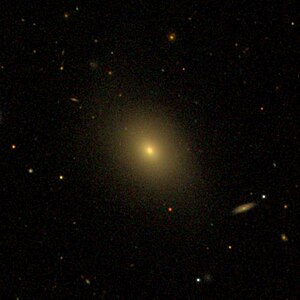NGC 967
| Galaxy NGC 967 |
|
|---|---|

|
|
| NGC 967 & LEDA 886650 (ru) SDSS image | |
| AladinLite | |
| Constellation | whale |
|
Position equinox : J2000.0 , epoch : J2000.0 |
|
| Right ascension | 02 h 32 m 12.7 s |
| declination | -17 ° 13 ′ 01 ″ |
| Appearance | |
| Morphological type | SAB0- |
| Brightness (visual) | 12.6 mag |
| Brightness (B-band) | 13.6 mag |
| Angular expansion | 1.6 ′ × 1 ′ |
| Position angle | 33 ° |
| Surface brightness | 13.2 mag / arcmin² |
| Physical data | |
| Redshift | 0.028910 ± 0.000093 |
| Radial velocity | 8667 ± 28 km / s |
|
Stroke distance v rad / H 0 |
(386 ± 27) · 10 6 ly (118.2 ± 8.3) Mpc |
| history | |
| discovery | John Herschel |
| Discovery date | November 10, 1835 |
| Catalog names | |
| NGC 967 • PGC 9654 • ESO 545-031 • MCG -03-07-030 • 2MASX J02321271-1713005 • SGC 022952-1726.2 • NPM1G -17.0096 • GALEXASC J023212.70-171300.5 | |
NGC 967 is an elliptical galaxy of Hubble type E / S0 in the constellation Cetus south of the ecliptic . It is estimated to be 386 million light years away from the Milky Way and has a diameter of around 185,000 ly.
In the same area of the sky is the galaxy NGC 989 .
The object was by astronomer John Herschel using on 10 November 1835 of a 18.7-inch - telescope discovered.
Web links
Individual evidence
